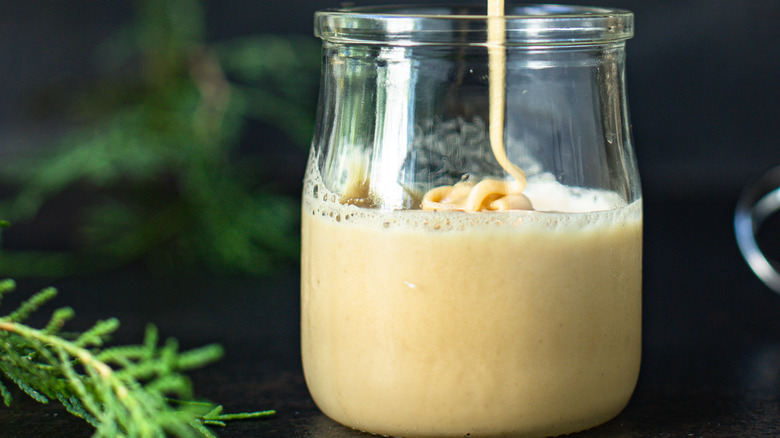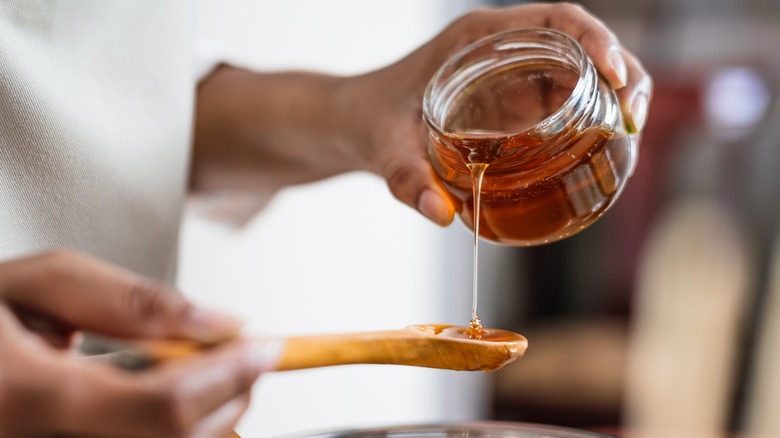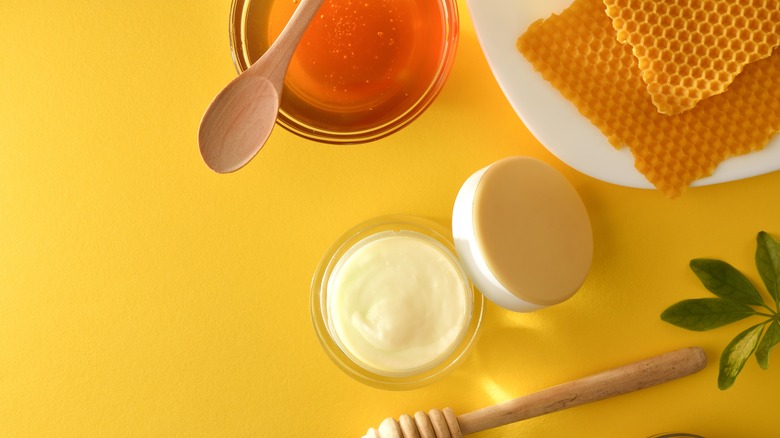Whipped Honey Is The One-Ingredient Topping That's Almost Too Easy To Make
Whether you are looking for an easy homemade gift idea or just a nice little treat for yourself, making whipped honey is a super simple process that offers dramatic results. You need only two things: A mixer and some honey.
Whipped honey is simply aerated honey. The most hands-off way to accomplish this is with a stand mixer. You can use a handheld mixer, but whipping by hand is not recommended unless you've been strength training. Put honey in your mixing bowl, and using the whisk attachment, let it whip on high until the honey achieves the desired consistency. Depending on how much honey you put in your mixer bowl, it could take anywhere from 10 minutes to 25 minutes for a lot of honey. Beware of burning out your stand mixer motor; don't just walk away from a home mixer that's running for an extended period.
When it is light and frothy, you have whipped honey to spread or drizzle on whatever your sweet tooth desires. Social media creator Katie Lee Wilken likes to whip honey to decrystallize it rather than going through the decrystallizing process and says it stays for a few months. Whenever it loses its aeration, she just whips it up again. Crystallized honey is perfectly fine to eat; it's just harder to work with. Whipping it will make a luxurious jar out of something that has gotten frustratingly solid.
Flavoring your whipped honey
One benefit of whipping your honey is that you can integrate flavoring into it. Adding spices to the honey before whipping is a great way to do this. Pumpkin pie spice and cinnamon are obvious choices, but cayenne pepper, chipotle, or ancho powder will bring some heat to your honey. Mix in vanilla bean paste or scrape some pods into the bowl to make a warm, vanilla-laced honey. For a beautiful floral honey perfect for tea time, use powdered edible flowers like lavender or rose. A little citrus zest brings some pep. Go wild experimenting with flavors you love.
It's worth remembering that natural, raw honey can begin to ferment when moisture is added to it. You won't end up with mead, but it can ferment like sourdough or kombucha. Adding ingredients that might raise the moisture content from honey's typical 18% to above 20% is enough to start fermentation. This isn't necessarily a bad thing, but it is something to keep in mind. It will certainly change the smell and taste of the honey, with some describing it as bread-like and others saying it starts smelling like orange juice.
What's the difference between whipped and creamed honey?
You might find jars of artisan creamed honey and wonder if it's the same as whipped honey. In short, it's not — it's a very different honey product.
Whipped honey is light, frothy, and airy. It's made, as you now know, by aerating honey, and it resembles whipped cream more closely than butter. Whipped honey will eventually lose its aeration, but creamed honey doesn't lose its creaminess. Creamed honey is made with very carefully controlled crystallization. Unlike the honey crystallizing into a grainy mess in your pantry, creamed honey features tiny, regular crystals. It has a smooth, velvety consistency and is quite thick. It doesn't drizzle; it's something you spread like butter or jam.
There's also a big difference between whipped honey and whipped honey butter. Whipped honey butter has been sweetened with honey; whipped honey, on the other hand, has no other ingredients. It is, very simply, whipped honey.


